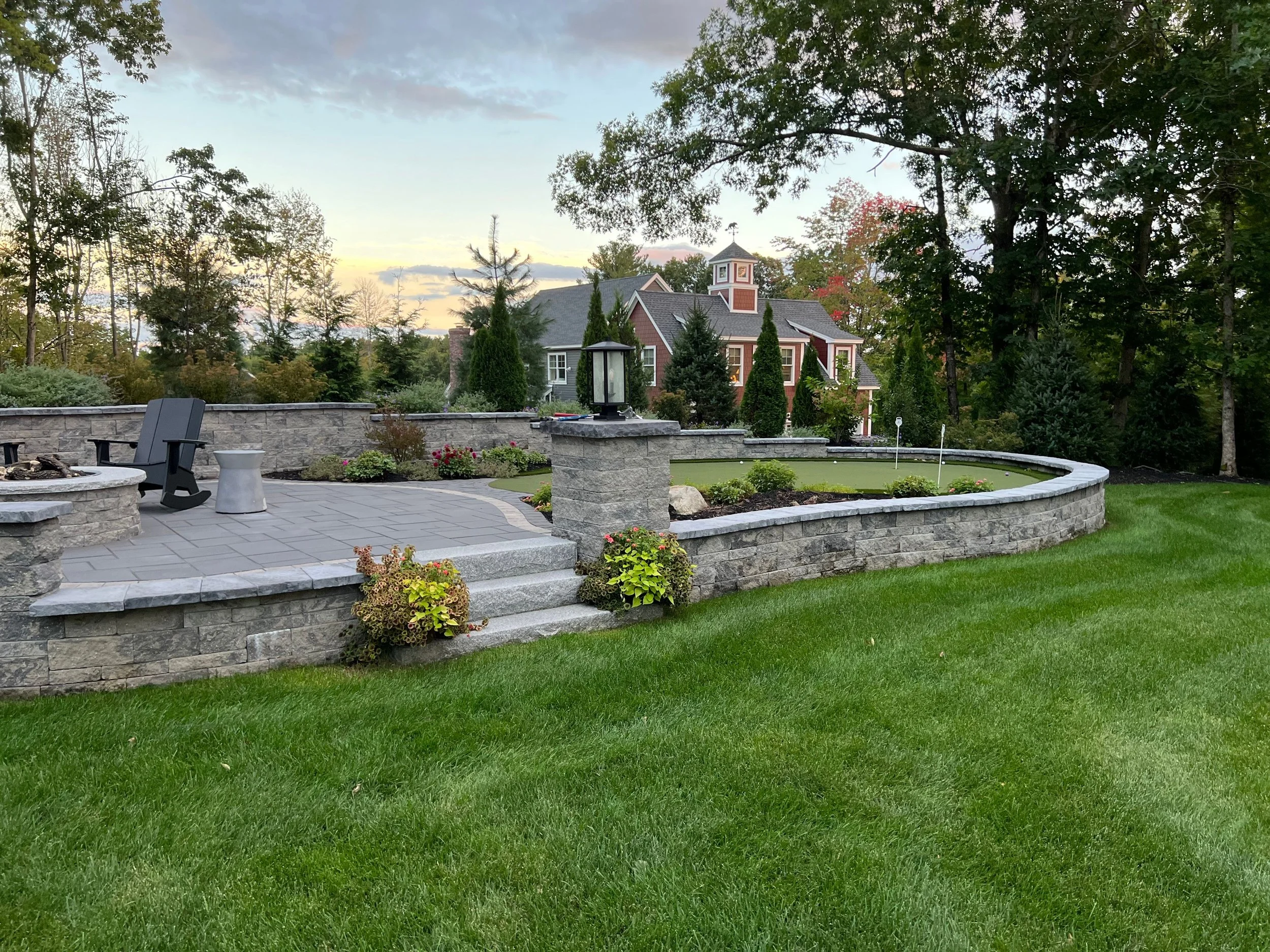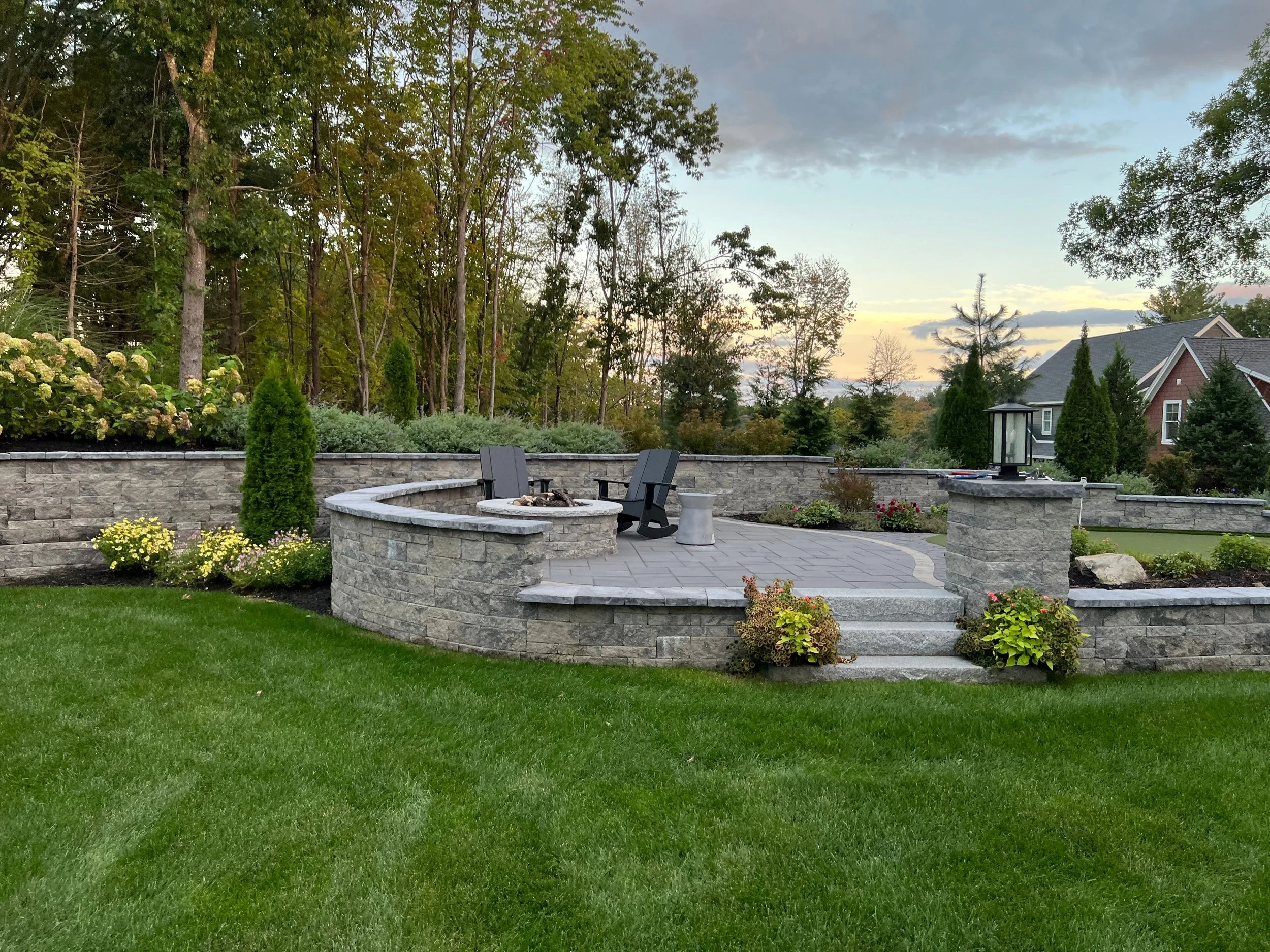How Landscape Design and Retaining Walls Create Cohesive Wellesley, MA, Backyards
Every outdoor space has the potential to feel well-organized and comfortable with the right design approach. Our team focuses on retaining wall and landscape design in Wellesley, MA, to create seamless outdoor environments that blend natural beauty with functional structure. Retaining walls define areas, shape movement, and provide strong foundations for planting beds, seating, and other outdoor features. By carefully pairing these walls with balanced landscaping, we create backyards that feel structured without losing their natural character.
Retaining Walls Establish Strong Structure
Retaining walls serve as more than just supportive features. They shape the flow of the entire backyard, creating natural divisions that guide where seating areas, plantings, or walkways might be placed. These walls also help stabilize slopes and uneven terrain, which opens up the potential to use areas that may have been overlooked before. A carefully placed retaining wall can transform steep or awkward spaces into level, functional areas that support outdoor living.
Our team focuses on designing walls that work with the natural grade of the land. We carefully evaluate soil conditions, drainage requirements, and the layout of the space to ensure each wall performs well over time. By integrating these structures into the overall landscape design, the backyard maintains a balanced blend of practicality and visual appeal.
The design process starts with understanding how homeowners want to use their outdoor space. We then layer in different levels, define areas for gathering, and make the overall space feel intentional and connected. When retaining walls are thoughtfully planned, they become part of the landscape rather than just a structure built to hold soil.
Creating Levels That Add Dimension
One of the most effective ways to make a backyard feel more dynamic is by introducing multiple levels. Retaining walls can define terraces, creating distinct spaces for dining, relaxing, or entertaining without disrupting the flow of the landscape. This approach is particularly useful in properties that have natural slopes or elevation changes.
These different levels make the backyard feel expansive and organized. They allow for creative placement of outdoor features such as fire pits, walkways, and structured seating areas. Our team ensures that transitions between these levels are smooth and welcoming, so each section feels connected rather than separate.
Each level can have its own character while remaining part of the overall plan. For example, one terrace might feature an outdoor dining table, while another could highlight plantings and soft landscape textures. This layered approach creates interest, encourages movement through the space, and adds depth to the entire outdoor environment.
Integrating Retaining Walls With Walkways
When retaining walls and walkways are designed together, they create a natural rhythm throughout the backyard. Walkways lead people through the space, and retaining walls help define where those routes begin and end. This relationship creates a sense of order without sacrificing creativity in the design.
Our team carefully considers placement, width, and the materials used for these walkways. Whether they connect a patio to a seating area or wind gently toward a feature like a water element, the layout is intentional. Retaining walls serve as subtle guides that keep the flow organized and structured.
The combination of walkways and walls also enhances the backyard visually. A walkway bordered by retaining walls or plantings draws the eye forward and gives the entire landscape a structured look. By blending these elements, we create outdoor spaces that are both functional and inviting.
Choosing Materials That Elevate Design
Material selection plays a significant role in how retaining walls and landscape design work together. The right stone, concrete, or block choice can help the space feel cohesive and polished. Our team evaluates textures, colors, and finishes that will enhance the overall landscape rather than distract from it.
Some homeowners prefer the natural look of stone, while others choose sleek, modern finishes. Both approaches can work well depending on the style of the home and the surrounding landscape. The goal is to make the materials feel like they belong, blending structure with softness from the plantings.
Material durability is also part of the design conversation. Since retaining walls serve a functional purpose, they need to stand up to time and weather. Our team ensures every selection supports both the structural integrity and the aesthetic appeal of the outdoor environment.
Retaining Walls and Plantings Work Hand in Hand
Pairing retaining walls with thoughtful plantings softens their structure and makes them feel like a natural part of the backyard. Plantings bring color, texture, and life to the space, creating contrast against the solid materials of the wall. This balance helps keep the landscape from feeling too rigid or harsh.
We select plantings that complement the wall’s scale and material. For example, low-growing plantings can highlight the clean lines of a wall, while taller plantings can add dimension and visual depth. Strategic placement ensures every plant plays a role in enhancing the wall’s impact.
Plantings also help define zones within the backyard. When combined with retaining walls, they can subtly separate spaces without the need for fences or barriers. The result is a landscape that feels layered, structured, and naturally beautiful.
Enhancing Outdoor Living Areas With Seating
Retaining walls can do more than support soil or define spaces. They can be designed to function as seating, adding versatility to patios, gathering spaces, or fire pit areas. Built-in seating along a retaining wall reduces the need for additional furniture, keeping the space open and organized.
This type of seating works well in both large and small backyards. It provides a clean, integrated look that enhances how people use the space. Whether it is a curved seating wall surrounding a fire feature or a straight line along a patio, the result feels intentional and cohesive.
Our team designs seating to fit the scale of the space and complement other features. We pay attention to proportions, height, and finishes so the seating blends seamlessly into the surrounding structural elements and plantings.
Outdoor Lighting Brings Structure to Life
Outdoor lighting is an essential element of any outdoor design. When paired with retaining walls, it enhances structure and creates ambiance in the evening. Subtle lighting can highlight the wall’s texture, define walkways, and make gathering spaces more inviting after dark.
Our team uses lighting strategically, focusing on function and effect. Lights can be installed along steps, built into the wall itself, or used to wash light across the surface. This thoughtful approach keeps the lighting integrated rather than feeling like an afterthought.
Lighting also contributes to the overall flow of the backyard. By illuminating key areas, it draws people into the space and encourages use throughout the evening. A well-lit retaining wall can turn a simple structure into a standout design feature.
Coordinating Retaining Walls With Patios
Patios often serve as the centerpiece of a backyard, and retaining walls can frame them beautifully. The wall may sit just behind a seating area, create a backdrop for an outdoor kitchen, or define the perimeter of the space. This pairing creates a clear sense of structure and purpose.
Our team considers how people will move between the patio and the rest of the backyard. The height and placement of the wall are carefully planned to ensure it enhances the patio rather than overpowering it. This makes the entire area feel more open and well-balanced.
By coordinating materials between the patio and the retaining wall, the space maintains a consistent look. This connection ties everything together and makes the backyard feel thoughtfully designed.
Connecting the Backyard With Walkways and Steps
Walkways and steps play an essential role in how people move through a backyard. When designed in harmony with retaining walls, they create smooth transitions between different levels and spaces. This makes the layout feel intuitive and easy to navigate.
Our team pays close attention to width, materials, and placement. Each element should support the flow of the backyard and complement the surrounding structural elements. Walkways can lead to patios, outdoor kitchens, seating areas, or planting beds.
Steps integrated into retaining walls are particularly effective for sloped properties. They provide direct access between levels while maintaining a polished and unified design. This careful coordination keeps the landscape balanced and structured.
Material and Color Coordination for a Unified Design
Color and material coordination are key to a cohesive backyard. When retaining walls, patios, and walkways share a complementary palette, the result feels elegant and intentional. Contrasting colors can be used strategically to highlight features without overwhelming the space.
Our team works with natural and manufactured materials that blend with the surrounding environment. We select textures and tones that fit the character of the home while elevating the design of the backyard. This level of attention creates a space that feels complete from every angle.
Whether the homeowner prefers warm earth tones, cool neutrals, or a mix of textures, we carefully balance each element. This coordination ensures the retaining walls feel like a natural extension of the landscape.
Is a Straight or Curved Retaining Wall Better?
Choosing between a straight and curved retaining wall depends on both aesthetics and function. Curved walls add softness and elegance to a backyard, creating a more natural flow between structural elements and plantings. They can help define specific areas such as seating zones, garden beds, or patio spaces, and offer visual interest from multiple angles. Straight walls, on the other hand, are ideal for maximizing space and providing a clean, modern look. They are often easier to construct and can accommodate longer stretches of elevation change. Our team evaluates the layout, slope, and intended use of the space to determine which style will complement your backyard while providing structural integrity. Each wall is carefully positioned to integrate with other features such as walkways, decks, and planting areas.
How Tall Should My Retaining Wall Be?
The height of a retaining wall is determined by the amount of soil it needs to hold and the overall landscape design. Low walls under three feet are perfect for creating visual separation or supporting flower beds and plantings without dominating the space. Taller walls, over four feet, may require engineered solutions, including reinforcements or footings to ensure long-term stability. The height also impacts the visual proportion in your backyard, providing the wall supports the design without overwhelming other elements. Our team measures slopes, soil type, and water drainage patterns to recommend the optimal height for your retaining wall. We ensure each wall functions effectively while harmonizing with the surrounding plantings and patios. Properly sized walls allow for both practical support and an appealing integration into the backyard design.
Creating Lasting Outdoor Impact
The best outdoor designs feel effortless because every element has a purpose. Retaining walls, walkways, patios, plantings, and outdoor lighting all work together to shape the experience of the backyard. When planned with care, the space remains functional, welcoming, and visually appealing year-round.
Our team approaches each project with a focus on connection and flow. We want every homeowner to step outside and immediately feel how well the space fits together. By blending structure and softness, we create backyards that are both elegant and practical.
Whether the goal is to define areas, manage elevation, or highlight features, retaining wall and landscape design can completely transform how a backyard feels and functions.
Related: 6 Ways a Retaining Wall in Weston and Groton, MA Enhances Your Outdoor Living Spaces


